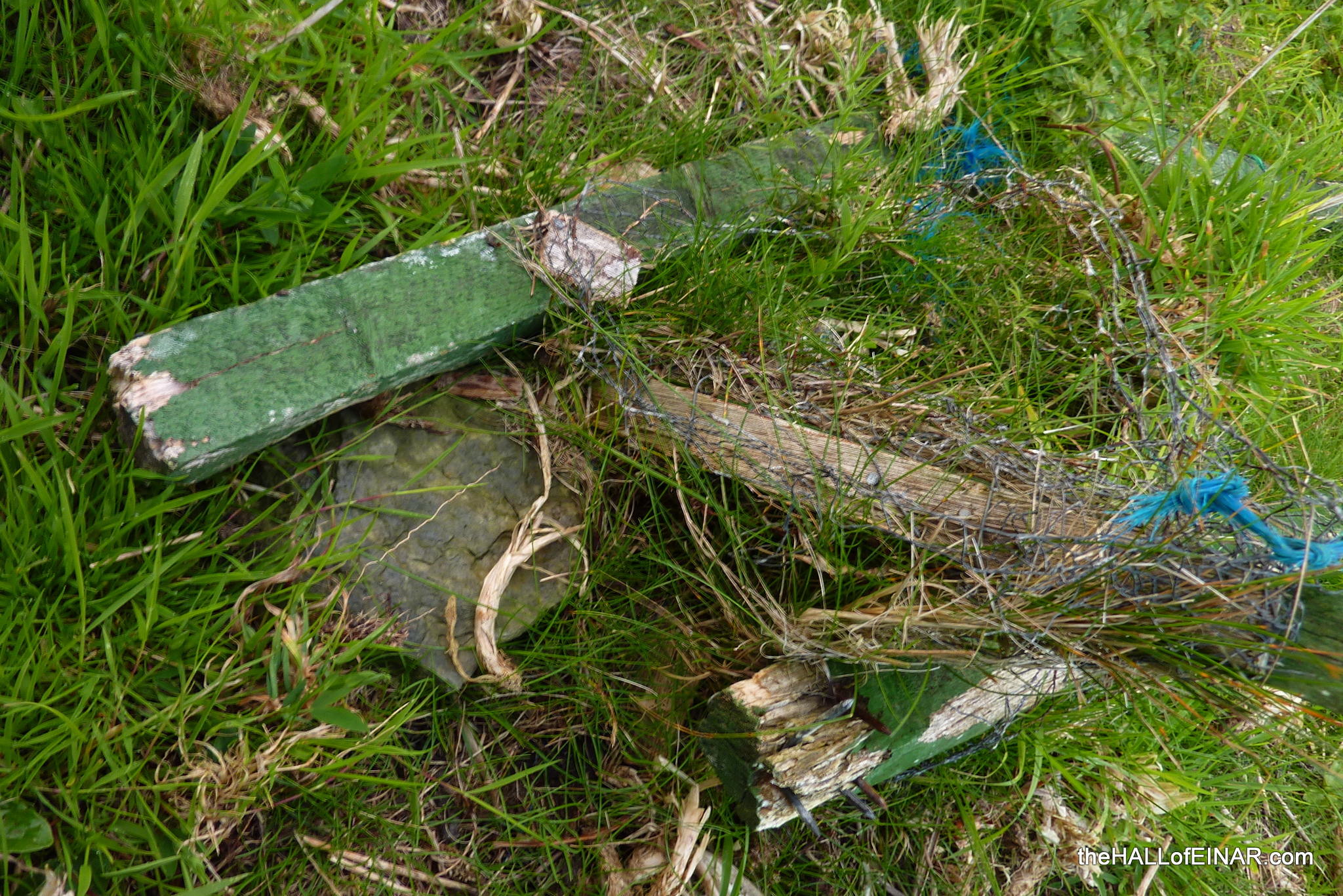Location of injury
Walking in the garden at the back of Einar I can see a mess of rotten wood painted green, tangled with chicken wire. I wonder what it was? It looks like the remains of a rabbit hutch.

Later, I’m leafing through the excellent book ‘The Skello Skeul’ written about Einar when it was the Skelwick Academy School. It was written and compiled by Nancy Scott in 2011 and published by the Westray Heritage Centre. It’s a collection of memories and records of the school. It has copies of the official inspection reports on the school, such as “The school should be washed every month”, and “In all classes the average age of the pupils is too high.”
In it there’s a section on The Rabbit Club. It makes fascinating reading:
“Sometime in the late 40s or early 50s the bicycle shed was transformed into the Rabbit Shed and in January 1951 the Rabbit Club was formed. No ordinary rabbits here though! Silver fox and white (Ermine Rex?) were purchased. George Kent, Primary 7, was involved in making the cages. He went back in on a Saturday to creosote them and remembers the pain on getting some in his eye, and Mr Orr washing it out with water.”
I’ve never had creosote in my eye. It does smell incredibly bad though. My old neighbour’s boyfriend decided to come round and use a power spray to creosote her shed for her one day. He sprayed it all over the garden wall and over my lettuce and salad vegetables. I was livid. He used to stand in her garden in the summer, barbecuing, telling me over the wall how he was in favour of global warming. He got her to mortgage the property and then left with all her money. She had to sell up. I’ve learned never to trust people who creosote my lettuce and who think global warming is a good thing.
I’m just thinking how cute it must have been in the 1950s to have pet rabbits in the school.
“The children wrote letters to purchase the rabbits and each day had to clean out the cages and provide the feed.”
There’s so much you can learn about people, and so many chances to grow as a good person from helping look after animals. It takes humanity to provide comfort to an animal and ensure it has all its needs met. Then I read on:
“The idea was to sell the skins and make money for the school funds.”
Hold on; they were going to kill the rabbits for money? Okay, that’s different then. I suppose the children were all from hardy farming stock and used to animals being there to kill. There goes my romantic notion of them learning to care for animals for caring’s sake. They were actually exploiting their deaths for money – and not even money for themselves, but for the School. Suddenly the bicycle shed has stopped being a cute petting area in my mind but has been transformed into a concentration camp for rabbit death.
“In actual fact more money was made from selling them as pets. At the Bazaar in 1951 nine young rabbits were sold by the Rabbit club, making £4-12-0.”
That’s what they think, anyway.
My dad had a pet rabbit during the Second World War. His friend bought it from him. When my dad saw his friend again, he asked him, “How’s the rabbit.” His friend said, “Oh, we ate it.” Times were hard back then.
The chicken wire is tough and I have to get some gloves to move it. My daughter was one of the children who had to feed and clean the rabbits at her primary school nearly 60 years later. One day she came home from school with a health and safety form. It detailed an accident at school. “What happened to you?” we said, looking worried. ‘Nature of injury’, it said: ‘Scratch.’ Underneath it said, ‘Location of injury: Rabbit hutch’. I laughed and laughed. But seriously, it can be quite nasty if a girl gets a scratch on her rabbit hutch. Luckily it was only a scratch on her finger.
There are rabbits all over Westray:

Sometimes there’s a black rabbit on the Island, but most are natural colours. I’m sure the black ones must be escapees, but I always refer to them as ‘The Black Bunny of Death’. Partly that’s because it’s amusingly ridiculous to call them that, but also because in some areas it was sterilised black rabbits, which were asymptomatic carriers of the deadly Myxomatosis disease, which were introduced to infect the rest of the population. Black ones were deliberately used so that the farmers wouldn’t shoot the black ones, as they wanted them to stay alive and carry out their deadly underground mission.
The book’s account continues.
“Coypu were also kept for a time. Skins from these were used to make gloves which were given to Mrs Margaret Ann Scott when she stopped teaching at the end of 1952.”
Coypu? Seriously? Giant South American rodents?

Coypu are huge semi-aquatic rodents – the second largest rodents on Earth. They were introduced into the UK in the 1930s on fur farms in counties like East Anglia and Devon. Some escaped and settled in well and it took until 1989 for the Ministry of Agriculture, Fisheries and Food to eradicate them.
I hope they kept Mrs Scott’s hands warm. Can you imagine that happening now?
I finish moving the rotten wood and chicken wire from the garden. It was probably a chicken coup and not a rabbit hutch at all. I take my gloves off. At least they’re not made of Coypu.
